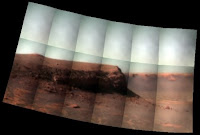I am stepping in as late last minute host for the Carnival of Space week 48. Thanks to Fraser Cain of Universe Today for letting me host. Send your Carnival of space entries for week 49 to carnivalofspace at gmail dot com.
We have Mars, Red Dwarfs, Astronomy meetings, 2001, Forbidden Planet, Dr Who, aliens that could hide their solar system and more.
From Centauri dreams we have Red Dwarfs: Dust, Details and Habitability
 One of three pictures in the red dwarf ariticle.
One of three pictures in the red dwarf ariticle.
Here Paul Gilster is looking at a recent paper on dust disks around red dwarfs, but the broader speculation is really about red dwarfs themselves and the odds on habitable planets around them. 75 million in our galaxy if we assume 1 per thousand stars — and the article goes on to look at the other assumptions in that statement, and contrasts red dwarfs to G and K stars.
From Ed Minchau at Space Feeds Every day, Space Feeds shows a space video of the day; from these Ed chooses a Space Video of the Week.

This week’s video is the classic 1956 science fiction movie Forbidden Planet.
From Hobby space and Space Transport News is
Surrey’s GIOVE-A : a full success
The GIOVE-A satellite, built and launched by Surrey Satellite, is another example of how an entrepreneurial, innovative, “NewSpace” style approach can succeed at rapid, low cost development of space systems.
David Portee at altairvi has a series of blog posts on the 40th anniversary of the film 2001. The film premiered 40 years ago today in Washington, DC. David’s blog series started on Monday and will continue through Sunday, April 6, when the trimmed-back version of the film screened for the first time in NYC. His first post gave the dates of 2001’s press screenings and premieres, and the second considered the inspiration behind the good ship Discovery. Today’s will look at a Earth-moon transportation proposal described in a paper with the title “2001: A Space Odyssey Revisited.” 
There will also be one in which he compare the monolith and the TARDIS and discuss our perceptions of superraces.

Dynamics of Cats at science blogs has NASA launches USS enterprise. Note the date of the article.
Martian Chronicles has an update on the Opportunity rover from Monday’s planning session. They are working on driving over close to a cliff in Victoria Crater called Cape Verde. They posted a low-resolution “thumbnail mosaic” of Cape Verde  See their links for more pictures.
See their links for more pictures.
as well as an image showing where the rover is now.
Another posting after the second rover planning meeting.
Starts with a bang has a little game called “Mars or Arizona?” He shows you pictures and you have to guess whether it’s a picture of Mars or a picture of Arizona. So far the highest score is 10/13.
From Cumbrian Sky we have what will Phoenix see [on Mars] when she opens her eyes?
Pamela Gay at Star Stryder
has IYA taking shape
Summary: IYA is taking shape – People and tools are all slowly emerging to make 2009 a year of great astronomical promise
Ian O’neill at Astroengine has a brief story about the recent sunspot activity and cycle overlap.
Orbiting frog is submiting the entire National Astronomy meeting blog They are covering the UK National Astronomy meeting which is on this week and since its a one-week thing. They are covering press releases from the UK and talks/poster sessions.
Astroprof’s Page has Too Much Radiation?
Summary: About radiation exposure to astronauts on long duration space missions.
A Babe in the Universe has Eruptions. Halma’uma’u crater on Hawaii’s Big Island is erupting and simultaneously our Cassini spacecraft has found organic molicules erupting from Saturn’s moon Enceladus
Earth and a distant moon share the phenomenon of internal heat sculpting their surfaces. Study of worlds like Enceladus offers clues to our own planet
My own Next Big Future entry Fermi Paradox, metamaterials and alien civilizations that are not distinguishable from dark matter.
Summary: Recently developed metamaterials are being developed to make objects that they surround invisible to microwaves and some optical wavelengths. They can also make things invisible to magnetic fields and sound and other waves. The Fermi paradox is based on assumptions about what aliens with advanced technology would or would not do and that the works of very advanced aliens should be visible to humans or that they or their robots should be greeting us like the galactic welcome wagon. Advanced aliens if they could build massive Dyson spheres could also make those things fade into the interstellar background. Plus we need to be humble and realistic in our assessment of how hard we have looked at the universe for life. This year we are finding that the Milky way is twice as thick as we thought (12000
light years not 6000) and last year the Andremeda Galaxy is five times bigger than we thought. These kinds of errors should tell us how clueless we are judging whether looking at some pinpoints of light tells us about whether there is or is not advanced life.

Brian Wang is a Futurist Thought Leader and a popular Science blogger with 1 million readers per month. His blog Nextbigfuture.com is ranked #1 Science News Blog. It covers many disruptive technology and trends including Space, Robotics, Artificial Intelligence, Medicine, Anti-aging Biotechnology, and Nanotechnology.
Known for identifying cutting edge technologies, he is currently a Co-Founder of a startup and fundraiser for high potential early-stage companies. He is the Head of Research for Allocations for deep technology investments and an Angel Investor at Space Angels.
A frequent speaker at corporations, he has been a TEDx speaker, a Singularity University speaker and guest at numerous interviews for radio and podcasts. He is open to public speaking and advising engagements.


Comments are closed.